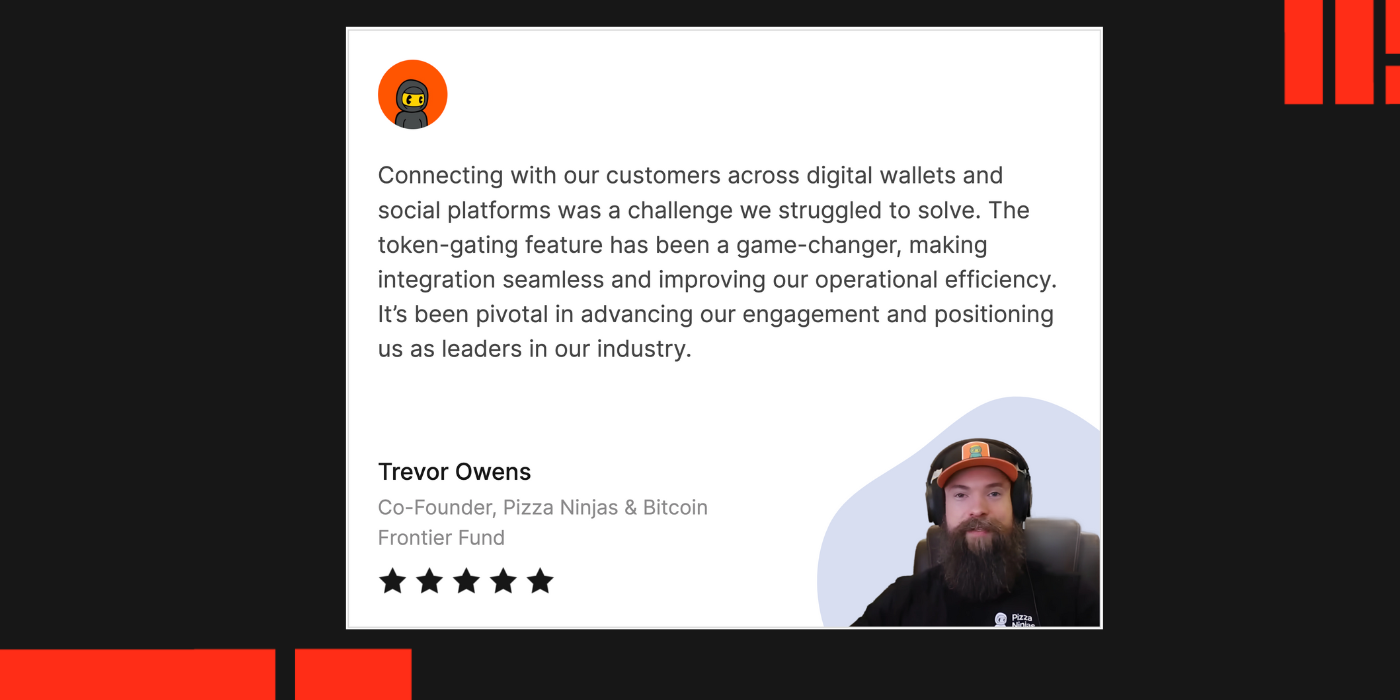Get insights.
Unlock value.
- 14-day free trial
- Set up in minutes
- No credit card required
Token Gated Forms & Surveys for Web3 Companies
Regular forms and surveys can feel like fishing in an ocean; you might get a lot of responses if you have a large community, but are they from the people who truly matter? How can you gather feedback from people who are truly your champions?
This is where Token Gating helps imagine getting feedback only from people who own a specific digital asset, such as a fungible token or NFT. Gain a better understanding of your Web3 audience or community and better insights from the data. To help web3 companies and audiences, BlockSurvey brings the Token Gating feature not just for data collection from the targeted audience, but with Token Gating; you ensure that only relevant participants, such as NFT holders, can access your forms and surveys. This makes your data more reliable and your NFT community feel special and engaged.
Understanding Token Gating for Access Control
In the Web3 world, Token gating grants access to online content, features, or resources by verifying the ownership of a specific digital asset, such as a fungible token or an NFT, stored in a crypto wallet. It could be either an FT or NFT. Users must prove token ownership to gain access.
When it comes to data collection through forms and surveys, you can use token-gated website or platforms like BlockSurvey to control access to exclusive content.
How Token Gating Works?
- When a user connects to their crypto wallet, the system checks whether the user holds the specific token in their wallet.
- If token ownership is verified, access to exclusive content is granted; otherwise, it's denied.
Why Should a Form/Survey Be Token Gated?
Gating a form or survey, especially with Token Gating in the Web3 context, offers several advantages:
- Targeted Audience Engagement: By gating your form or survey with FT or NFT ownership, you ensure that only individuals who are genuinely interested or invested in your project or community participate. This leads to stronger community building and more meaningful interactions. Customer story: How Yuga Labs collected feedback from 1,000 NFT holders using BlockSurvey’s Token Gating feature? Read More!
- Enhanced Data Quality: Token gating helps filter out irrelevant or spam responses, ensuring the data you collect is more accurate and reliable. By focusing on participants who hold specific tokens or NFTs, you're more likely to receive valuable feedback and insights relevant to your project or community.
- Exclusivity and Engagement: Token gating creates a sense of exclusivity and rewards for token holders, fostering a stronger sense of community engagement and loyalty. Participants feel special and recognized for their involvement, which can lead to increased participation and commitment.
- Governance and Decision-Making:In Web3 environments, token gating can also be used as Web3 identity verification to grant voting rights or access to governance decisions only to token holders. This ensures that decisions are made by invested community members, increasing transparency and decentralization.
- Incentives and Rewards: Token gating can be utilized to offer exclusive benefits, rewards, or early access to products or features for token holders. This incentivizes participation and encourages community members to actively engage with your project or platform.
How to Use BlockSurvey as Token-Gated Forms & Surveys for Your Web3 Project?
Follow the below guide for setup:
- Step 1: Choose Your Network: Choose your network to start with. BlockSurvey supports popular blockchain technology networks such as Bitcoin, Ethereum, Solana, and more. Once the network is selected under the Gating tab, choose whether you want to gate by Fungible vs Non-Fungible, Allowlist.
- Step 2: Set up your token for gating: Choose the token or NFT-based ownership criteria. To get started quickly, we have added the tokens and contracts of the most active Web3 projects. Multiple token gating conditions can also be set. If you don’t see your project, select “other” and add the contract address of your token and you are good to go. More details in the next step.
- Step 3:Adding Custom Tokens: If you have a project that is not listed, use the 'Other' option to add your Token name, Token contract address, and minimum holding(s). Set custom digital asset parameters, including NFT drops or fungible token values, for tailored access control. This ensures your form or survey is gated based on your token.
- Token Name is the descriptive label for a particular cryptocurrency or token.
- Contract address is the identifier for a specific smart contract on a blockchain.
- Token Decimals are the smallest divisible unit or precision level of a token.
- Minimum holding value is the least amount of a token or asset one must hold to meet a specific requirement or criteria.
- Step 4: Hit Publish: Once everything is set, publish it and share the URL of the BlockSurvey from the 'Share' screen. Participants will need to connect wallet for exclusive access.
- Step 5: Test your token-gating setup: Open up the BlockSurvey URL, and do a test submission from your wallet. If good, ask your respondents to participate.
When respondents answer the form or survey, they sign in using the network's wallet. For Stacks and Bitcoin, we support Leather, Xverse, UniSat, and OKX wallet. Similarly, we support major wallets like Metamask, Phantom for Ethereum, Polygon, and Solana. Upon connecting to the wallet and signing a message, no transactions are made on the chain. BlockSurvey token gate using API and the wallet address to check for holdings. If holdings are met, we let the user submit, or else users cannot.
Note: For EVM-based chains, BlockSurvey supports further checks for delegation through Warm.xyz and Delegate.xyz by this, your audience can safely use a delegated warm wallet rather than a cold wallet for participating in gated forms & surveys.

What are Some Use Cases You Can Unlock Using BlockSurvey for Token Gating?
Reward your NFT community with exclusive content, such as private articles, videos, exclusive events or NFT drops. Here are some real-world use cases for token-gated websites and communities.
- Exclusive Content Access: A decentralized content platform could use token gating to provide exclusive articles, videos, or podcasts only to users who hold a certain amount of a specific token. For instance, a blockchain-based music streaming service might release a new album that only token holders can listen to. Customer Story: How BlockSurvey Helped Smartists Music Score Distribution with Token Gating? Read More!
- VIP Event Access: A Web3 conference or event could offer special VIP tickets that are only accessible to individuals who possess a specific token. Benefit: Token gating creates a sense of exclusivity and rewards loyal community members, enhancing their engagement. Gives your holders access to exclusive events.
- Early Product Releases: A decentralized app (dApp) could grant early access to new features, updates, or items to users who hold a certain token
- Governance and Voting Rights: In decentralized autonomous organizations (DAOs), token gating can be used to restrict voting rights to those who hold a governance token. This ensures that only invested community members can influence important decisions.
- Airdrops and Rewards: Token projects might airdrop new tokens or rewards to holders of an existing token. This can be used to reward loyal users or to distribute governance tokens. Additionally, they can create token-gated surveys to engage the community and gather valuable feedback from token holders.
- Exclusive NFT Access: A decentralized art gallery platform could utilize token gating with allowlist to grant exclusive access to limited-edition NFT artworks. Users must hold specific NFTs in their wallet, along with a minimum balance of a designated fungible token. This grants them access to private exhibitions or early releases of new NFT collections.
- Exclusive Ticket Sale: An event organizer could use token gating to offer exclusive ticket sales for high-demand events and get payment through Stripe. By requiring attendees to hold a specific amount of a designated token, to gain early access to ticket purchases before they are made available to the general public. Customer Story: Check out the Ninjalerts Yacht Party in Hong Kong. The exclusive event RSVP was managed using BlockSurvey.
1/ EXCITED TO PRESENT
— trevor.btc (@TO) April 29, 2024
NINJA•YACHT🍕🥷
Exclusive @Pizza_Ninjas Event at Ordinals Asia!
Join us for a 4-hour scenic tour of Hong Kong's beautiful Victoria Harbour aboard a real yacht (pics below) 👇
Onboard we'll serve some of HK's best pizza, craft cocktails, & have two… pic.twitter.com/RPXUjPaqjr
Conclusion
By using BlockSurvey’s Token Gating feature, you can ensure that your data collection efforts are targeted towards the people who truly matter, your true community members - those who hold specific tokens or NFTs in their digital wallets. This makes your data more reliable and fosters a sense of exclusivity and engagement among your audience. So why wait? Set up Token Gating and unlock a whole new level of engagement and better insights from your Web3 audience. BlockSurvey is aware of the modern needs of Forms & Surveys for Web3 Companies. When you explore the Web3 world, remember BlockSurvey is here to help with your data collection.
Token Gated Forms & Surveys for Web3 Companies FAQ
What is Token Gating?
Token Gating is a method to control access to content, events, or features by verifying if someone owns a specific token or NFT in their crypto wallet. It’s commonly used in Web3 communities to ensure exclusivity and engagement.
What is the role of digital identity in Token Gated Forms & Surveys?
Digital identity can be used to grant access to the forms and surveys, ensuring only authorized users can participate, and can also facilitate the secure collection and storage of data.
How to Token Gate a Survey?
Choose a blockchain, set up token criteria (like token type and minimum holdings), and publish the survey. Participants connect their wallets for verification, and only eligible users can access and submit the survey.
What tokens are supported by BlockSurvey for Token Gating?
BlockSurvey supports a variety of tokens on multiple blockchain networks, including Bitcoin, Stacks, Solana, Ethereum, Polygon, Avalanche, BNB, Celo, and Gnosis. You can use both fungible tokens (FTs) and non-fungible tokens (NFTs) for token gating your surveys and forms.
Can I use my custom token for Token Gating on BlockSurvey?
Yes, you can use custom tokens on BlockSurvey. If your token is not listed, you can manually add it by entering the contract address, token name, and minimum holding requirements.
Get insights.
Unlock value.
- 14-day free trial
- Set up in minutes
- No credit card required





